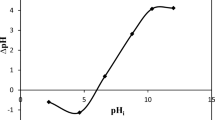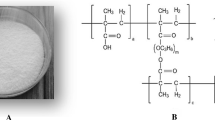Abstract
The adsorption of Pb(II) by pumice samples collected from the Mount Ararat region, located in eastern Turkey, was investigated in a batch system. The combined and individual effects of operating parameters on adsorption were analyzed using a multi-step response surface methodology. In the first step the most effective factors, which are initial Pb(II) concentration, pH, and temperature, were determined via fractional factorial design. Then the steepest ascent/descent followed by central composite design were used to interpret the optimum adsorption conditions for the highest Pb(II) removal. The optimum adsorption conditions were determined to be initial Pb(II) concentration of 84.30 mg/L, pH of 5.75, and temperature of 41.11 °C. At optimum conditions, the adsorption capacity of pumice for Pb(II) was found to be 7.46 mg/g according to a removal yield of 88.49 %. The obtained data agreed with a second-order rate expression and fit the Langmuir isotherm very well. The thermodynamic parameters such as ΔH°, ΔS°, and ΔG° for the Pb(II) adsorption were calculated at four different temperatures. The present results indicate that pumice is a suitable adsorbent material for adsorption of Pb(II) from aqueous solutions.








Similar content being viewed by others
References
Abdel-Halim SH, Shehata AMA, El-Shahat MF (2003) Removal of lead ions from industrial wastewater by different types of natural materials. Water Res 37:1678–1683
Abo-Farhaa SA, Abdel-Aala AY, Ashourb IA, Garamona SE (2009) Removal of some heavy metal cations by synthetic resin purolite C100. J Hazard Mater 169:190–194
Adebowale KO, Unuabonah IE, Olu-Owolabi BI (2006) The effect of some operating variables on the adsorption of lead and cadmium ions on kaolinite clay. J Hazard Mater 134:130–139
Ajmal M, Rao RAK, Anwar S, Ahmad J, Ahmad R (2003) Adsorption studies on rice husk: removal and recovery of Cd(II) from wastewater. Bioresour Technol 86:147–149
Anirudhan TS, Sreekumari SS (2011) Adsorptive removal of heavy metal ions from industrial effluents using activated carbon derived from waste coconut buttons. J Environ Sci 23:1989–1998
Bée A, Talbot D, Abramson S, Dupuis V (2011) Magnetic alginate beads for Pb(II) ions removal from wastewater. J Colloid Interface Sci 362:486–492
Bulut Y, Baysal Z (2006) Removal of Pb(II) from wastewater using wheat bran. J Environ Manage 78:107–113
Cadena F, Rizvi R, Peters RW (1990) Feasibility studies for the removal of heavy metals from solution using tailored bentonite. In: Hazardous and industrial wastes, Proceedings of the twenty-second mid-Atlantic industrial waste conference, Drexel University, pp 77–94
Caliskan N, Kul AR, Alkan S, Gokirmak Sogut E, Alacabey I (2011) Adsorption of Zinc(II) on diatomite and manganese-oxide-modified diatomite: a kinetic and equilibrium study. J Hazard Mater 193:27–36
Chen H, Zhao J, Dai G, Wu J, Yan H (2010) Adsorption characteristics of Pb(II) from aqueous solution onto a natural biosorbent, fallen Cinnamomum camphora leaves. Desalination 262:174–182
Doyurum S, Celik A (2006) Pb(II) and Cd(II) removal from aqueous solutions by olive cake. J Hazard Mater 138:22–28
Dubinin MM, Radushkevich LV (1947) Equation of the characteristics curve of activated charcoal. Chem Zent 1:875
Elovich SY, Larinov OG (1962) Theory of adsorption from solutions of non electrolytes on solid (I) equation adsorption from solutions and the analysis of its simplest form (II), verification of the equation of adsorption isotherm from solutions. Izv Akad Nauk SSSR Otd Khim Nauk 2:209–216
Erdem M, Ozverdi A (2005) Lead adsorption from aqueous solution onto siderite. Sep Purif Technol 42:259–264
Ersoy B, Sariisik A, Dikmen S, Sariisik G (2010) Characterization of acidic pumice and determination of its electrokinetic properties in water. Powder Technol 197:129–135
Freundlich HMF (1906) Über die adsorption in lösungen. Z Phys Chem (Leipzig) 57A:385–470
Goel J, Kadirvelu K, Rajagopal C, Garg VK (2005) Removal of lead(II) by adsorption using treated granular activated carbon: batch and column studies. J Hazard Mater 125:211–220
Hara T, Endo T, Ikeda K, Inaba N (1979) Concentration of heavy metal ions by use of synthetic pumice and its related adsorbents. Sci Eng Rev Doshisha Univ 20:1625
Jiang M, Wang Q, ** X, Chen Z (2009) Removal of Pb(II) from aqueous solution using modified and unmodified kaolinite clay. J Hazard Mater 170:332–339
Karatas M (2012) Removal of Pb(II) from water by natural zeolitic tuff: kinetics and thermodynamics. J Hazard Mater 199–200:383–389
Kardam A, Raj KR, Srivastava S, Srivastava MM (2013) Nanocellulose fibers for biosorption of cadmium, nickel, and lead ions from aqueous solution. Clean Techn Environ Policy. doi:10.1007/s10098-013-0634-2
Katsumata H, Kaneco S, Inomata K, Itoha K, Funasaka K, Masuyama K, Suzuki T, Ohta K (2003) Removal of heavy metals in rinsing wastewater from plating factory by adsorption with economical viable materials. J Environ Manage 69:187–191
Lagergren S (1898) Zur theorie der sogenannten adsorption gelöster stoffe. Kungliga Svenska Vetenskapsakademiens, Handlingar, pp 1–39
Langmuir I (1918) The adsorption of gases on plane surfaces of glass, mica and platinum. J Am Chem Soc 40:1361–1403
Leppert D (1990) Heavy metal sorption with clinoptilolite zeolite: alternatives for treating contaminated soil and water. Min Eng 42:604–608
Li Q, Zhai J, Zhang W, Wang M, Zhou J (2007) Kinetic studies of adsorption of Pb(II), Cr(III) and Cu(II) from aqueous solution by sawdust and modified peanut husk. J Hazard Mater 141:163–167
Li Y, Zhang FS, **u FR (2009) Arsenic(V) removal from aqueous system using adsorbent developed from a high iron-containing fly ash. Sci Total Environ 407:5780–5786
Liu Y, Shen X, **an Q, Chen H, Zou H, Gao S (2006) Adsorption of copper and lead in aqueous solution onto bentonite modified by 4-methylbenzo-15-crown-5. J Hazard Mater 137:1149–1155
Lo W, Chua H, Lam KH, Bi SH (1999) A comparative investigation on the biosorption of lead by filamentous fungal biomass. Chemosphere 39:2723–2736
Lodeiro P, Barriada JL, Herrero R, Sastre de Vicente ME (2006) The marine macroalga Cystoseira baccata as biosorbent for cadmium(II) and lead(II) removal: kinetic and equilibrium studies. Environ Pollut 142:264–273
Ma X, Li L, Yang L, Su C, Wang K, Yuan S, Zhou J (2012) Adsorption of heavy metal ions using hierarchical CaCO3–maltose meso/macroporous hybrid materials: adsorption isotherms and kinetic studies. J Hazard Mater 209–210:467–477
Machida M, Aikawa M, Tatsumoto H (2005) Prediction of simultaneous adsorption of Cu(II) and Pb(II) onto activated carbon by conventional Langmuir type equations. J Hazard Mater 120:271–275
Merrikhpour H, Jalali M (2012) Waste calcite sludge as an adsorbent for the removal of cadmium, copper, lead, and zinc from aqueous solutions. Clean Technol Environ Policy 14:845–855
Miretzky P, Munoz C, Cantoral-Uriza E (2011) Cd2+ adsorption on alkaline-pretreated diatomaceous earth: equilibrium and thermodynamic studies. Environ Chem Lett 9:55–63
Mittal A, Krishnan L, Gupta VK (2005) Removal and recovery of malachite green from wastewater using agricultural waste material, de-oiled soya. Sep Purif Technol 43:125–133
Moradi O, Aghaie M, Zare K, Monajjemi M, Aghaie H (2009) The study of adsorption characteristics Cu2+ and Pb2+ ions onto PHEMA and P(MMA-HEMA) surfaces from aqueous single solution. J Hazard Mater 170:673–679
Myers RH, Montgomery DC (2002) Response surface methodology. Wiley, New York, p 43
Ngah WSW, Fatinathan S (2010) Adsorption characterization of Pb(II) and Cu(II) ions onto chitosan-tripolyphosphate beads: kinetic, equilibrium and thermodynamic studies. J Environ Manage 91:958–969
Ozay O, Ekici S, Baran Y, Kubilay S, Aktas N, Sahiner N (2010) Utilization of magnetic hydrogels in the separation of toxic metal ions from aqueous environments. Desalination 260:57–64
Ozer A, Ozer D, Ozer A (2004) The adsorption of copper(II) ions on to dehydrated wheat bran (DWB): determination of the equilibrium and thermodynamic parameters. Process Biochem 39:2183–2191
Pandey KK, Prasad G, Singh VN (1985) Copper removal from aqueous solutions by fly ash. Water Res 19(7):869–873
Panuccio MR, Sorgona` A, Rizzo M, Cacco G (2009) Cadmium adsorption on vermiculite, zeolite and pumice: batch experimental studies. J Environ Manage 90:364–374
Paulino AT, Belfiore LA, Kubota LT, Muniz EC, Almeida VC, Tambourgi EB (2011) Effect of magnetite on the adsorption behavior of Pb(II), Cd(II), and Cu(II) in chitosan-based hydrogels. Desalination 275:187–196
Perrott KW (1977) Surface charge characteristics of amorphous aluminosilicates. Clay Clay Miner 25:417–421
Raji C, Anirudhan TS (1997) Chromium(VI) adsorption by sawdust: kinetics and equilibrium. Indian J Chem Technol 4:228–236
Rao RAK, Khan MA (2007) Removal and recovery of Cu(II), Cd(II) and Pb(II) ions from single and multimetal systems by batch and column operation on neem oil cake (NOC). Sep Purif Technol 57:394–402
Rashid K, Suresh Kumar Reddy K, Shoaibi AA, Srinivasakannan C (2013) Sulfur-impregnated porous carbon for removal of mercuric chloride: optimization using RSM. Clean Technol Environ Policy. doi:10.1007/s10098-012-0564-4
Sahan T, Ceylan H, Sahiner N, Aktas N (2010) Optimization of removal conditions of copper ions from aqueous solutions by Trametes versicolor. Bioresour Technol 101:4520–4526
Sakurai K, Ohdate Y, Kyuma K (1988) Comparison of salt titration and potentiometric titration methods for the determination of zero point of charge (ZPC). Soil Sci Plant Nutr 34(2):171–182
Sakurai K, Ohdate Y, Kyuma K (1989) Factors affecting zero point of charge (ZPC) of variable charge soils. Soil Sci Plant Nutr 35(1):21–31
Sarı A, Tuzen M (2009) Kinetic and equilibrium studies of biosorption of Pb(II) and Cd(II) from aqueous solution by macrofungus (Amanita rubescens) biomass. J Hazard Mater 164:1004–1011
Sarı A, Tuzen M, Soylak M (2007a) Adsorption of Pb(II) and Cr(III) from aqueous solution on Celtek clay. J Hazard Mater 144:41–46
Sarı A, Tuzen M, Cıtak D, Soylak M (2007b) Equilibrium, kinetic and thermodynamic studies of adsorption of Pb(II) from aqueous solution onto Turkish kaolinite clay. J Hazard Mater 149:283–291
Sarı A, Tuzen M, Cıtak D, Soylak M (2007c) Adsorption characteristics of Cu(II) and Pb(II) onto expanded perlite from aqueous solution. J Hazard Mater 148:387–394
Sekar M, Sakthi V, Rengaraj S (2004) Kinetics and equilibrium adsorption study of lead (II) on activated carbon prepared from coconut shell. J Colloid Interface Sci 279:307–313
Singh KK, Talat M, Hasan SH (2006) Removal of lead from aqueous solutions by agricultural waste maize bran. Bioresour Technol 97:2124–2130
Su S, Nie H, Zhu L, Chen T (2009) Optimization of adsorption conditions of papain on dye affinity membrane using response surface methodology. Bioresour Technol 100:2336–2340
Sugashini S, Meera Sheriffa Begum KM (2013) Optimization using central composite design (CCD) for the biosorption of Cr(VI) ions by cross linked chitosan carbonized rice husk (CCACR). Clean Technol Environ Policy 15:293–302
Tiwari D, Kim H, Lee S (2007) Removal behavior of sericite for Cu(II) and Pb(II) from aqueous solutions: batch and column studies. Sep Purif Technol 57:11–16
Yadava KP, Tyagi BS, Singh VN (1991) Effect of temperature on the removal of lead(II) by adsorption on China clay and wollastonite. J Chem Technol Biotechnol 51:47–60
Yetilmezsoy K, Demirel S, Vanderbei RJ (2009) Response surface modeling of Pb(II) removal from aqueous solution by Pistacia vera L.: Box–Behnken experimental design. J Hazard Mater 171:551–562
Yu B, Zhang Y, Shukla A, Shukla SS, Dorris KL (2001) The removal of heavy metals from aqueous solutions by sawdust adsorption removal of lead and comparison of its adsorption with copper. J Hazard Mater 84:83–94
Zulkali MMD, Ahmad AL, Norulakmal NH (2006) Oryza sativa L. husk as heavy metal adsorbent: optimization with lead as model solution. Bioresour Technol 97:21–25
Acknowledgments
This work was supported by the Yuzuncu Yil University Research Fund with Grant # 2011-FBE-YL038.
Author information
Authors and Affiliations
Corresponding author
Rights and permissions
About this article
Cite this article
Şahan, T., Öztürk, D. Investigation of Pb(II) adsorption onto pumice samples: application of optimization method based on fractional factorial design and response surface methodology. Clean Techn Environ Policy 16, 819–831 (2014). https://doi.org/10.1007/s10098-013-0673-8
Received:
Accepted:
Published:
Issue Date:
DOI: https://doi.org/10.1007/s10098-013-0673-8




